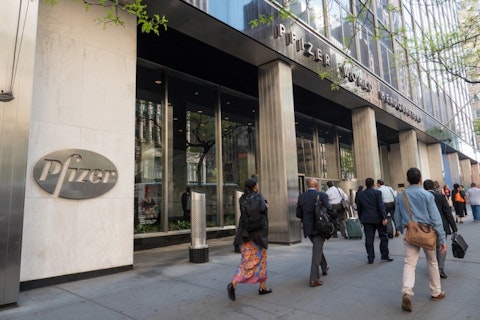Pfizer Inc. (NYSE:PFE) is a blue-chip dividend stock that has paid a consistent dividend for multiple decades.
Furthermore, over the last 20 years the total dividends paid per share has increased at a nearly 10% compound annual growth rate (CAGR).
In recent years, however, Pfizer’s total dividend growth rate has slowed and the payout ratio is now over 90%.
Should investors be concerned that this global pharmaceutical giant’s best days are behind it or, worse, that another dividend cut could be forthcoming?

pio3 / Shutterstock.com
Let’s start with a look at the business.
Business Analysis
Pfizer was incorporated in 1942 and today is a global biopharmaceutical company with operations all across the globe. Their portfolio of products includes mainly medicines and vaccines.
The company has engaged in significant merger and acquisition activity over the years and has even increased its appetite more recently.
In November 2015, Pfizer announced a merger with Allergan, another global pharmaceutical company. However, the deal was scrapped after the U.S Treasury unveiled new rules to curb tax inversion deals.
One recent mega deal Pfizer did execute was its acquisition of Hospira for $15.7 billion, which closed in the summer of 2015. Hospira is one of the leading providers of sterile injectable drugs and infusion technologies.
Overall, Pfizer is one of the largest pharmaceutical companies in the world, generating revenues of nearly $49 billion and spending $7.7 billion on research and development in 2015.
They operate the business through three reporting segments: the Global Innovative Pharmaceutical segment (GIP); Global Vaccines, Oncology and Consumer Healthcare (VOC); and the Global Established Pharmaceutical segment (GEP).
The GIP business (29% of revenue) focuses on developing and commercializing medicines that improve patients’ lives. Key therapeutic areas include inflammation/immunology, cardiovascular/metabolic, neuroscience/pain and rare diseases.
The VOC business (26% of revenue) focuses on the development and commercialization of vaccines and products for oncology and consumer healthcare.
The GEP business (44% of revenue) includes legacy brands that have lost or will soon lose market exclusivity in both developed and emerging markets, branded generics, generic sterile injectable products, biosimilars and infusion systems.
Overall, Pfizer had 8 therapeutics or family of therapeutics that contributed over a billion dollars to 2015 revenues, while their top ten accounted for around 47% of total revenue. Their top therapeutics are some that consumers might recognize, such as Lyrica and Viagra, but also include relatively new therapeutics as well.
Pfizer’s largest therapeutics in 2015 were Lyrica (Epilepsy), Enbrel (arthritis), Viagra (Erectile dysfunction), the Prevnar family of therapeutics (pneumococcal vaccines), Sutent (various carcinomas), Lipitor (cholesterol), and the Premarin family (menopause).
Pfizer Inc. (NYSE:PFE) had significant revenue concentration in these products in 2015, including 13% of revenue in the Prevnar family, 10% in Lyrical, 7% in Enbrel, 3.8% in Lipitor, 3.5% in Viagra, 2.3% in Sutent, and 2% in the Premarin family.
There are many positive characteristics in investing in a pharmaceutical company, including recession resistant products, but investors really need to be aware of patent expirations on any of the therapeutics in the portfolio.
Some more recent exclusivity losses on major products include Lyrica in July 2014 in major European markets, Enbrel in the summer of 2015 in Japanese and European markets and with US exclusivity ending in December 2016, and Zyvox in 2015 in the US and January of 2016 in major European markets.
Pfizer’s strategy for building the pipeline of new therapeutics is through M&A and internal R&D investment. This is critical for the company’s future growth.
As of February 2016, they had a number of projects in different R&D stages. They had 34 discovery projects in Phase 1, 18 in Phase 2, 30 in Phase 3, and 8 in Registration.
Furthermore, Pfizer has executed a couple of very large transactions recently to rebuild the pipeline. In addition to the 2015 Hospira deal, so far in 2016 they have executed two large deals to obtain potentially blockbuster therapeutics.
In May of 2016, Pfizer announced that they will acquire Anacor Pharmaceuticals Inc (NASDAQ:ANAC) for a total transaction value of $5.2 billion, assuming conversion of outstanding convertible notes.
Anacor’s main commercial product is Kerydin, a toenail-fungus ointment, but Pfizer seems to be more excited about eczema treatment crisaborole. Pfizer estimates that crisaborole could reach peak sales of $2 billion.
In addition to the Anacor deal, Pfizer is set to acquire Medivation Inc (NASDAQ:MDVN) for $14 billion. Medivation is a biotech company whose only product is prostate cancer medication Xtandi. Xtandi’s growth potential was the main rational behind the deal as it is growing rapidly and even being tested for other applications including breast cancer.
Follow Pfizer Inc (NYSE:PFE)
Follow Pfizer Inc (NYSE:PFE)
Receive real-time insider trading and news alerts



